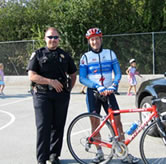If you thought that all your work is finished at least until December, think again! October is the time to finish your ultimate test for the 2006 race season, transition to the off season, and plan for the 2007 season.
Training in the Off-Season
Starting in November, SportVelo will add two indoor, off-season workouts to help you stay fit when the weather gets dreary and the days get dark. (See the new Calendar for the schedule.)
Testing
The end of the season is a perfect time to perform a benchmark, last-of-season field test that demonstrates your fitness. Additionally, the data that we collect from the test is a challenge for us: we always like to do better, and I know that if I enter next season at or better than the testing from the fall, I’ll race well!For all my athletes who finished their seasons and are anticipating a little time off, wait! Nothing wrong with a little time off, just make sure you complete your testing before you enter your off season.Testing generally means a timed test over a specific distance. Make sure you go into the test somewhat rested, but certainly not overtrained or overrested. For my local athletes, Canada road is a great 20min test for cyclists, and a 5K such as the Palo Alto Moonlight run works well for runners.
Transition and Planning
Once you have completed your season and completed your testing, it’s time for your transition from racing to your off-season. It’s time to rest, recharge, recover, and in general, give yourself a break. However, the transition period doesn’t mean doing nothing! Make sure you continue to take care of yourself – watch your diet and get plenty of sleep. And be careful: with less activity, you can easily fall into the trap of overeating. Prepare to transition into your strength phase by going to the gym a couple times a week. Avoid high-intensity workouts, such as fast group rides, and consider some easy swimming and light running.During this downtime, honestly assess your season and your performances, think about your weaknesses and strengths, and plan how you want to improve for the next season. Think about your top three list – what are your top three goals for racing and training next season? Winning a specific race or championship? Or a training goal, such as a sub 40 min 10K? Be honest with yourself – you want to set realistic goals for next year. Instead of “take 10min off my 40K time”, keep that ultimate goal in the back of your mind, but start, for example, by aiming to reduce your 40K time by 5%. Here’s an example of a cyclist’s top three list:
Training goals:
- Stay consistent with training plan and complete training logs
- Improve threshold power by 5%
- Improve sprint power and positioning during races
Racing goals:
- Top three in the women’s masters National road race
- Sub 1hr 40K ITT at districts
- Consistently place top 10% in local races
You’ll notice that all these goals are measurable and specific. At the end of the season, this athlete can easily answer “yes” or “no” to these goals to assess her season.
Next, here is my favorite part of this process: think about your racing season, choose those races that you want to race in 2007, and rate them from important to training race. We’ll pull all this information into an annual plan for next year.
Off-Season Training
Starting in November, SportVelo is proud to partner with Al Painter to expand the Monday morning core workouts into two more workouts. Designed as an indoor winter training session to combat the cold and dark, the Tuesday evening workout at 6:30PM is an indoor cycling session with intervals and core work. We’ve also added a Wednesday 6:30PM strength workout that can be one of your strength workouts during the off season. These training sessions will begin in November, so check the new calendar for all SportVelo workouts, as well as races where SportVelo athletes are competing.
SportVelo Reaches Out to Schools

On September 8, SportVelo met with 400 enthusiastic students at Oak Knoll Elementary School in Menlo Park , California to talk about bicycles. Dan, along with Al Painter and nutritionist MaryAnn Levenson, joined the Menlo Park police to talk about bike safety. They covered what to wear and what to eat, as well as properly fitted helmets and controlled riding. They answered all sorts of questions from students, such as, “Do I really have to signal when I want to make a turn, even if there are no cars around?”

Dan Smith, Al Painter, and 400 curious students.
At the end, Dan and Al demonstrated the activities that the kids also completed, such as controlled riding, signaling, and stopping at stop signs. The kids spent a fun morning learning about bikes and showering Dan with questions.
Dan Smith and the Menlo Park police.